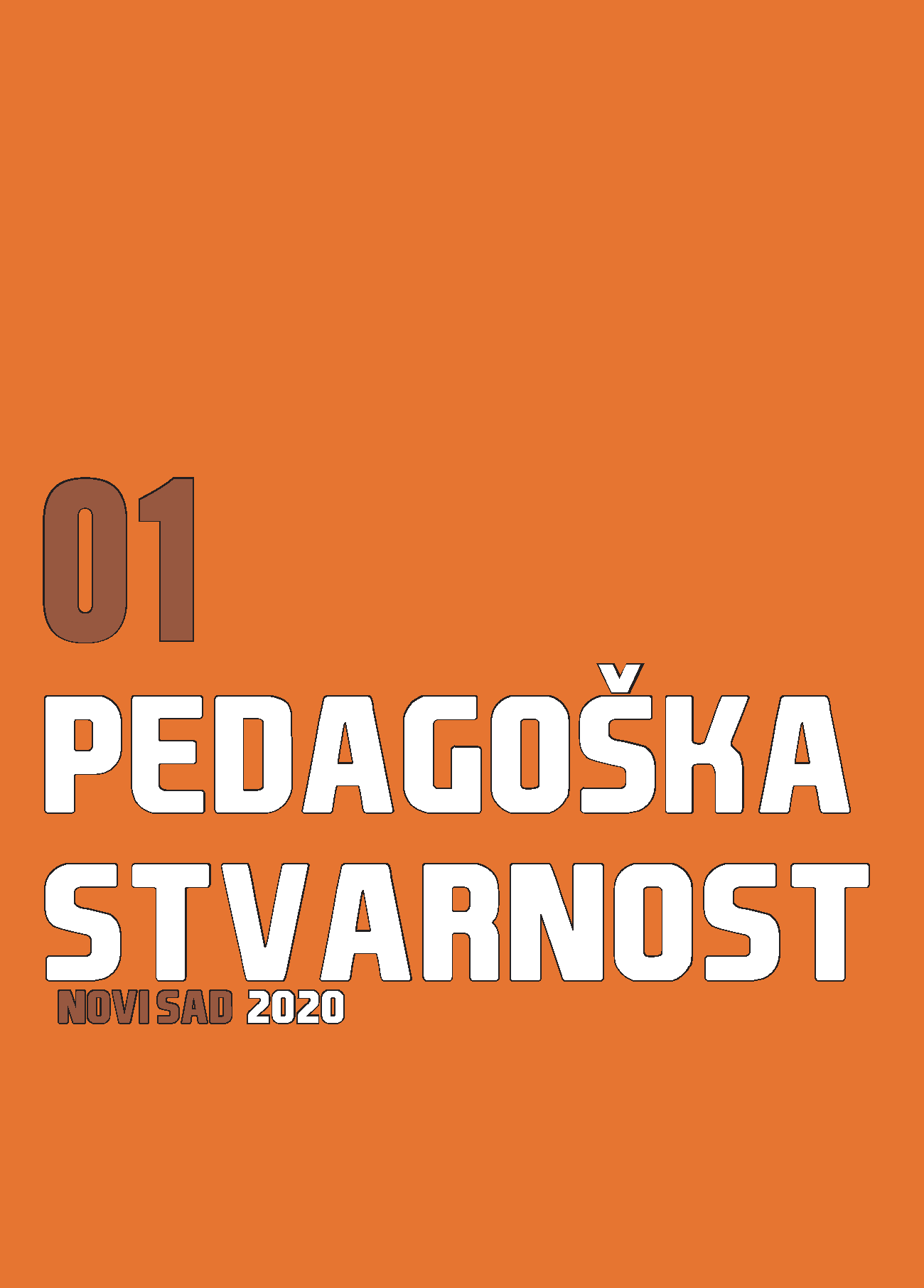ŠKOLSKI USPEH KOD DECE SA PONAŠANJIMA KARAKTERISTIČNIM ZA HIPERKINETIČKI POREMEĆAJ
Originalni naučni rad
Apstrakt
U poslednjih nekoliko decenija istraživanja ukazuju na porast broja dece sa hiperkinetičkim poremećajem. Jedan od mnogih problema sa kojima se ova deca suočavaju je i niže školsko postiguće, uprkos prosečnoj inteligenciji. Ove rane poteškoće u obrazovanju često imaju dugoročno loše ishode – niži nivo obrazovanja i manju uspešnost u obavljanju zanimanja u odraslom dobu. Negativna iskustva u okviru školskog sistema imaju negativne uticaje i na odnose sa roditeljima, nastavnicima i vršnjacima, doprinose nižem samopouzdanju i emocionalnim poteškoćama. U radu smo ispitivali razlike u školskom postignuću između dece koja pokazuju ponašanja karakteristična za hiperkinetički poremećaj i dece koja ne ispoljavaju probleme u održavanju pažnje i hiperaktivnosti. Uzorak se sastojao od učiteljskih procena oko 800 učenika nižih razreda osnovnih škola. Učitelji su na skali IVJER procenjivali prisutnost simptoma prosečnom ocenom na polugodištu. Rezultati pokazuju da deca koja pokazuju ponašanja karakteristična za hiperkinetički poremećaj imaju statistički značajno niži školski uspeh u odnosu na decu bez simptoma (U=36025.0, p≤.001). Kada pogledamo razlike po podtipu hiperkinetičkog poremećaja, vidimo da deca sa ponašanjima karakterističnim za mešoviti i pretežno nepažljivi tip imaju niže školsko postignuće nego deca sa ponašanjima karakterističnim za pretežno hiperaktivni tip i deca bez simptoma (χ2=192.62, p≤.001). Naši rezultati ukazuju na to da nije hiperaktivnost, već problem pažnje ono što doprinosi nižem školskom uspehu.
Reference
Barkley, R. A., DuPaul, G. J., & McMurray, M. B. (1990). Comprehensive evaluation of attention deficit disorder with and without hyperactivity as defined by research criteria. Journal of consulting and clinical psychology, 58(6), 775.
Barry, T. D., Lyman, R. D., & Klinger, L. G. (2002). Academic underachievement and attention-deficit/hyperactivity disorder: The negative impact of symptom severity on school performance. Journal of School Psychology, 40(3), 259-283.
Baumgaertel, A., Wolraich, M. L., & Dietrich, M. (1995). Comparison of diagnostic criteria for attention deficit disorders in a German elementary school sample. Journal of the American Academy of Child & Adolescent Psychiatry, 34(5), 629-638.
Bied, A., Biederman, J., & Faraone, S. (2017). Parent-based diagnosis of ADHD is as accurate as a teacher-based diagnosis of ADHD. Postgraduate Medicine, 129(3), 375-381.
Biirah, J., Anika, A., & Zigler, R. S. (2018). Influence of Attention-Deficit Hyperactivity Disorder (ADHD) on Academic Achievement of Learners in International Primary Schools in Mombasa (Kenya) and Kampala (Uganda): A Comparative Study. European Scientific Journal, 14(29), 199.
Breslau, N., Breslau, J., Peterson, E., Miller, E., Lucia, V. C., Bohnert, K., & Nigg, J. (2010). Change in teachers’ ratings of attention problems and subsequent change in academic achievement: A prospective analysis. Psychological Medicine, 40, 159-166.
Carlson, C. L., & Mann, M. (2000). Attention-deficit/hyperactivity disorder, predominantly inattentive subtype. Child and Adolescent Psychiatric Clinics of North America, 9(3), 499-510.
Daley, D., & Birchwood, J. (2010). ADHD and academic performance: why does ADHD impact on academic performance and what can be done to support ADHD children in the classroom? Child: Care, Health and Development, 36(4), 455–464.
Diamantopoulou, S., Rydell, A., Thorell, L. B. & Bohlin, G. (2007) Impact of executive functioning and symptoms of attention deficit hyperactivity disorder on children’s peer relations and school performance. Developmental Neuropsychology, 32, 521–542.
DuPaul, G. J., Gormley, M. J., & Laracy, S. D. (2013). Comorbidity of LD and ADHD: Implications of DSM-5 for assessment and treatment. Journal of Learning disabilities, 46(1), 43-51.
DuPaul, G. J., & Stoner, G. (2003). ADHD in the schools: Assessment and intervention strategies 2nd ed. New York: Guilford.
Faraone, S. V., Sergeant, J., Gillberg, C., & Biederman, J. (2003). The worldwide prevalence of ADHD: is it an American condition? World Psychiatry: Official Journal Of The World Psychiatric Association (WPA), 2(2), 104-113.
Fergusson, D. M., & Horwood, L. J. (1995). Early disruptive behavior, IQ, and later school achievement and delinquent behavior. Journal of Abnormal Child Psychology,23, 183-199.
Fergusson, D. M., Horwood, L. J., & Lynskey, M. T. (1993). The effects of conduct disorder and attention deficit in middle childhood on offending and scholastic ability at age 13. Journal of Child Psychology and Psychiatry, 34, 899-916.
Fergusson, D. M., Lynskey, M. T., & Horwood, L. J. (1997). Attentional difficulties in middle childhood and psychosocial outcomes in young adulthood. Journal of Child Psychology and Psychiatry, 38, 633-644.
Frazier, T. W., Youngstrom, E. A., Glutting, J. J., & Watkins, M. W. (2007). ADHD and achievement: Meta-analysis of the child, adolescent, and adult literature and a concomitant study with college students. Journal of Learning Disabilities, 40, 49-65.
Golubović, Š., Jerković, I.,Rapaić, D. (2008) Sposbnost održavanja pažnje i ispoljavanje hiperaktivnosti i impulsivnosti u zavisnosti od pola deteta. Pedagogija, 63 (3), 465-471.
Haack, L. M., Villodas, M., McBurnett, K., Hinshaw, S., & Pfiffner, L. J. (2017). Parenting as a mechanism of change in psychosocial treatment for youth with ADHD, predominantly inattentive presentation. Journal of Abnormal Child Psychology, 45(5), 841-855.
Hechtman, L., Abikoff, H., Klein, R. G., Weiss, G., Respitz, C., Kouri, J., … Pollack, S. (2004). Academic achievement and emotional status of children with ADHD treated with long-term methylphenidate and multimodal psychosocial treatment. Journal of the American Academy of Child and Adolescent Psychiatry, 43(7), 812–819.
Hinshaw, S. P. (1992). Academic underachievement, attention deficits, and aggression: Comorbidity and implications for intervention. Journal of Consulting and Clinical Psychology, 60, 893–903.
Hinshaw, S. P. (1992). Externalizing behavior problems and academic underachievement in childhood and adolescence: causal relationships and underlying mechanisms. Psychological bulletin, 111(1), 127.
Hinshaw, S. P., & Melnick, S. M. (1995). Peer relationships in boys with attention-deficit hyperactivity disorder with and without comorbid aggression. Development and psychopathology, 7(4), 627-647.
Karoly, L. A., Kilburn, M. R., & Cannon, J. S. (2006). Early childhood interventions: Proven results, future promise. Rand Corporation.
Langberg, J. M., Molina, B. S., Arnold, L. E., Epstein, J. N., Altaye, M., Hinshaw, S. P., . . .Hechtman, L. (2011). Patterns and predictors of adolescent academic achievement and performance in a sample of children with attention-deficit/ hyperactivity disorder. Journal of Clinical Child & Adolescent Psychology, 40, 519-531.
Lee, Steve S., and Stephen P. Hinshaw (2006). Predictors of adolescent functioning in girls with attention deficit hyperactivity disorder (ADHD): the role of childhood ADHD, conduct problems, and peer status. Journal of Clinical Child and Adolescent Psychology35 (3), 356-368.
Loe, I. M., & Feldman, H. M. (2007). Academic and educational outcomes of children with ADHD. Ambulatory Pediatrics: The Official Journal of the Ambulatory Pediatric Association, 7(1 Suppl), 82–90.
Mannuzza, S., Klein, R. G., Bessler, A., Malloy, P., & Hynes, M. E. (1997). Educational and occupational outcome of hyperactive boys grown up. Journal of the American Academy of Child & Adolescent Psychiatry, 36(9), 1222- 1227.
Massetti, G. M., Lahey, B. B., Pelham, W. E., Loney, J., Ehrhardt, A., Lee, S. S., & Kipp, H. (2008). Academic achievement over 8 years among children who met modified criteria for attention-deficit/hyperactivity disorder at 4-6 years of age. Journal of Abnormal Child Psychology, 36, 399-410.
McGee, R., Prior, M., Williams, S., Smart, D. & Sanson, A. (2002) The long-term significance of teacher-rated hyperactivity and reading ability in childhood: findings from two longitudinal studies. Journal of Child Psychology and Psychiatry and Allied Disciplines, 43, 1004–1017.
Merrell, C. & Tymms, P. B. (2001). Inattention, hyperactivity and impulsiveness: their impact on academic achievement and progress. British Journal of Educational Psychology, 71, 43–56.
Milich, Richard, Amy C. Balentine, and Donald R. Lynam (2001). ADHD combined type and ADHD predominantly inattentive type are distinct and unrelated disorders. Clinical psychology: science and practice,8 (4) 463- 488.
Moldavsky, M., Groenewald, C., Owen, V., & Sayal, K. (2013). Teachers’ recognition of children with ADHD: Role of subtype and gender. Child and Adolescent Mental Health, 18(1), 18-23.
Murphy, Kevin R., Russell A. Barkley, and Tracie Bush. (2002). Young adults with attention deficit hyperactivity disorder: subtype differences in comorbidity, educational, and clinical history. The Journal of nervous and mental disease190, (3), 147-157.
Murphy, S. (2014). Inclusive strategies for students with characteristics of ADHD. Young Children, 69(3), 66 -71.
Pfiffner, L. J., Hinshaw, S. P., Owens, E., Zalecki, C., Kaiser, N. M., Villodas, M., McBurnett, K. (2014). A two-site randomized clinical trial of integrated psychosocial treatment for ADHD-inattentive type. Journal of consulting and clinical psychology, 82(6), 1115.
Polanczyk, G. V., Willcutt, E. G., Salum, G. A., Kieling, C., & Rohde, L. A. (2014). ADHD prevalence estimates across three decades: an updated systematic review and meta-regression analysis. International journal of epidemiology, 43(2), 434-442.
Raggi, V., & Chronis, A. (2006). Interventions to address the academic impairment of children and adolescents with ADHD. Clinical Child and Family Psychology Review, 9, 85-111.
Rapport, Mark D., Sean W. Scanlan, and Colin B. Denney (1999). Attention-deficit/ hyperactivity disorder and scholastic achievement: A model of dual developmental pathways. The Journal of Child Psychology and Psychiatry and Allied Disciplines40, (8), 1169-1183.
Rodriguez, Alina, Marjo-Riitta Järvelin, Carsten Obel, Anja Taanila, Jouko Miettunen, Irma Moilanen, Tine Brink Henriksen et al. (1999). Do inattention and hyperactivity symptoms equal scholastic impairment? Evidence from three European cohorts. BMC Public Health 7 (1), 327.
Ross, Catherine, and John Mirowsky (2003). Education, social status, and health (social institutions and social change).
Salla, J., Michel, G., Pingault, J. B., Lacourse, E., Paquin, S., Galéra, C., … Côté, S. M. (2016). Childhood trajectories of inattention-hyperactivity and academic achievement at 12 years. European Child & Adolescent Psychiatry, 25(11), 1195–1206.
Semrud-Clikeman, Margaret, Joseph Biederman, Susan Sprich-Buckminster, Belinda Krifcher Lehman, Stephen V. Faraone, and Dennis Norman (1992). Comorbidity between ADDH and learning disability: A review and report in a clinically referred sample.” Journal of the American Academy of Child & Adolescent Psychiatry 31, (3), 439-448.
Svetska Zdravstvena Organizacija (1992). ICD-10 Klasifikacija mentalnih poremećaja i poremećaja ponašanja. Klinički opisi i dijagnostička uputstva. Beograd: Za- vod za udžbenike i nastavna sredstva.
Takeda, T., Nissley-Tsiopinis, J., Nanda, S., & Eiraldi, R. (2016). Factors associated with a discrepancy in parent–teacher reporting of symptoms of ADHD in a large clinic-referred sample of children. Journal of attention disorders, 1087054716652476.
Thomas, Cindy Parks, Peter Conrad, Rosemary Casler, and Elizabeth Goodman (2006). Trends in the use of psychotropic medications among adolescents, 1994 to 2001. Psychiatric services57 (1), 63-69.
Thorell, L. B. (2007). Do delay aversion and executive function deficits make distinct contributions to the functional impact of ADHD symptoms? A study of early academic skill deficits. Journal of Child Psychology and Psychiatry, 48(11), 1061-1070.
Weithorn, C. J., & Marcus, M. (1985). High-active children and achievement tests: A two-year follow-up. Psychology in the Schools, 22, 449-458.
Wolraich, M. L. (1999). Attention deficit hyperactivity disorder: The most studied and yet most controversial diagnosis. Mental Retardation & Developmental Disabilities Research Reviews, 5(3), 163-168.
van der Kolk, Annemarie, Michel van Agthoven, Jan Buitelaar, and L. Hakkaart (2015). A Systematic Review of Literatures on Factors Associated with Educational and Academic Performance in Attention Deficit Hyperactivity Disorder. Creative Education 6, 164-180.
Visser, S. N., Danielson, M. L., Bitsko, R. H., Holbrook, J. R., Kogan, M. D., Ghan- dour, R. M.,... & Blumberg, S. J. (2014). Trends in the parent-report of health care provider-diagnosed and medicated attention-deficit/hyperactivity disorder: United States, 2003–2011. Journal of the American Academy of Child & Adolescent Psychiatry, 53(1), 34-46.







